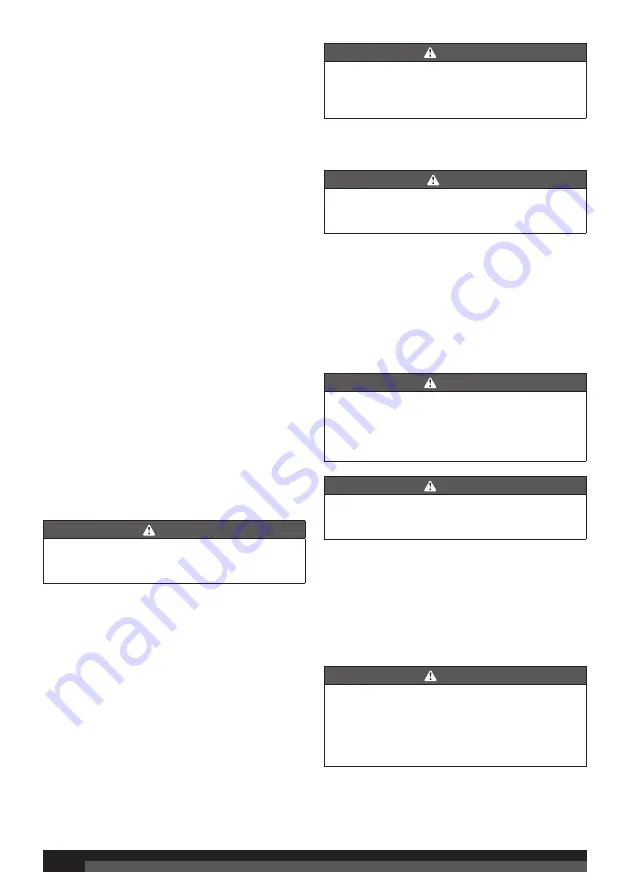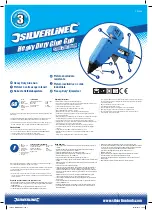
5
APPLICATIONS
You may use this tool for the purposes listed below:
●
Finish and trim (Interior and exterior)
●
Door & window casing
●
Door jambs
●
Baseboard
●
Crown molding
●
Cabinetry
●
Molding
●
Staircases
●
Door and window trim
●
Chair rail
●
Brickmold
●
Hardwood flooring
●
Paneling
●
Furniture
PREPARING THE TOOL FOR USE
See figure 2.
Under normal use conditions, the tool should be
lubricated before connecting the tool to an air supply.
Add air tool lubricant into the air fitting on the tool once
daily with minimal use, or twice a day with heavy use.
Only a few drops of oil at a time is necessary. Too much
oil will only collect inside the tool and will be noticeable in
the exhaust cycle.
Before connecting the tool, check the air compressor
gauge to be sure it is functioning within the proper range
of 4.8 - 8.3 bar (70 - 120 psi).
NO-MAR PAD
See figure 3.
The no-mar pad attached to the nose of the tool helps
prevent marring and denting when working with softer
woods.
WARNING
Disconnect the tool from the air supply before
removing or replacing the no-mar pad. Failure to do so
could result in serious personal injury.
The pad can be removed by pulling it down and away
from the nose. To replace the pad, fit it into place over the
nose and push up at the back to reseat.
On-board storage for the pad is located on the magazine
of the tool. An extra no-mar pad is provided in the on-
board storage area.
ADJUSTING THE EXHAUST
See figure 4.
The adjustable exhaust on the end cap of the tool allows
the operator to direct the exhaust according to operator
preference.
To adjust, turn the exhaust cap in the desired direction.
WARNING
Disconnect the tool from the air supply before leaving
the work area, moving the tool to another location, or
handing the tool to another person. Failure to do so
could result in serious personal injury.
CONNECTING THE TOOL TO AN AIR SUPPLY
See figure 5.
DANGER
Do not use oxygen, combustible gases or bottled
gases as a power source for this tool. The tool will
explode and cause death or serious injury.
This tool is designed to operate on clean, dry compressed
air at regulated pressures between 4.8 - 8.3 bar (70 - 120
psi). The correct air pressure is the lowest pressure that
will do the job.
NOTE:
Air pressure that is higher than 8.3 bar (120 psi)
may damage the tool.
The tool and air hose must have a hose coupling that
allows all pressure to be removed from the tool when the
coupling is disconnected.
WARNING
Always use a coupling that discharges all the
compressed air in the tool at the time the fitting or
hose coupling is disconnected. Using a coupling that
does not discharge the compressed air could cause
unintended operation and serious personal injury.
WARNING
Do not climb rigging or scaffolding while carrying a tool
that is connected to an air hose. Doing so could result
in serious personal injury.
Connect the tool to the air supply with a 1/4 in. female
quick connector. A 3/8 in. female quick connector may
be used in situations where a 1/4 in. supply line is not
available. For maximum tool performance, a 3/8 in.
supply line and fittings are required.
LOADING THE TOOL WITH NAILS
See figure 6 - 7.
WARNING
The tool’s driving mechanism may cycle when the tool
is first connected to the air supply. Always connect the
tool to a pressurized air supply before loading nails to
prevent injury from unintended cycling. Always make
sure the tool’s magazine is empty at the beginning of
each work session, before connecting to an air supply.
1. Connect the tool to the air supply.
2. With the nose of the tool pointed away from you, feed
a strip of nails into the magazine. Be sure the nails
are pointed downward and at the angle shown.
Содержание AFNDA2565
Страница 1: ...AFNDA2565 ANGLED FINISH NAILER ORIGINAL INSTRUCTIONS ...
Страница 2: ...2 1 4 10 9 8 7 5 6 3 4 9 11 12 Fig 1 Fig 2 Fig 3 ...
Страница 3: ...1 2 15 16 17 1 13 7 14 5 2 8 4 Fig 4 Fig 6 Fig 5 Fig 7 Fig 8 Fig 9 ...
Страница 4: ...19 6 10 21 7 20 18 1 2 Fig 10 Fig 12 Fig 11 ...
Страница 15: ......
Страница 16: ......

































